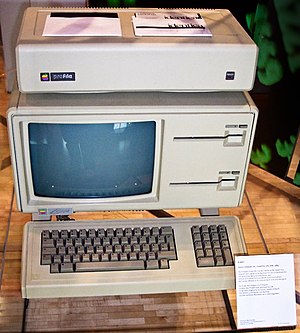Apple Lisa

Apple Lisa, with an Apple ProFile external hard disk sitting atop it. Note the dual 5.25-inch "Twiggy" floppy drives.
|
|
| Also known as | Local Integrated System Architecture |
|---|---|
| Developer | Apple Inc. |
| Manufacturer | Apple Inc. |
| Type | Personal computer |
| Release date | January 19, 1983 |
| Introductory price | US$ 9,995 (1983) US$ 24,000 (2016 equivalent) |
| Discontinued | August 1986 |
| Units sold | 100,000 |
| Operating system | Lisa OS, Xenix |
| CPU | Motorola 68000 @ 5 MHz |
| Predecessor |
Apple II Plus Apple III |
| Successor |
Macintosh XL Macintosh |
Apple Lisa was a desktop computer developed by Apple, released on January 19, 1983. It was one of the first personal computers to offer a graphical user interface (GUI) in a machine aimed at individual business users. Development of the Lisa began in 1978, and it underwent many changes during the development period before shipping at the very high price of US$9,995 with a 5 MB hard drive. The high price, relatively low performance and unreliable "Twiggy" floppy disks led to poor sales, with only 100,000 units sold.
In 1982, after Steve Jobs was forced out of the Lisa project, he joined the Macintosh project, at that time developing a much more limited machine with a task-switching interface. Jobs redirected the Macintosh team to build a cheaper and better Lisa, releasing it in January 1984 and quickly outstripping Lisa sales. Newer versions of the Lisa were introduced that addressed its faults and lowered its price considerably, but it never really picked up sales compared to the much less expensive Mac. The final revision of the Lisa, the Lisa 2/10, was modified and sold as the Macintosh XL.
Generally considered a failure, the Lisa nevertheless introduced a number of advanced features that would not re-appear on the Macintosh for a number of years. Among these was an operating system which featured protected memory and preemptive multitasking, and a more document-oriented workflow. The hardware itself was also much more advanced than the Macintosh, with a hard drive and support for up to 2 megabytes (MB) of RAM, expansion slots and a larger higher-resolution display. The main exception being that while the Macintosh also used the 68000 processor, the Macintosh initially used a version clocked at 7.89Mhz, compared to the 5Mhz version used in the Lisa. The complexity of the Lisa operating system and its associated programs overtaxed the slower processor enough that users perceived it to be sluggish, particularly when scrolling in documents.
...
Wikipedia
